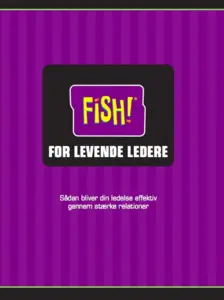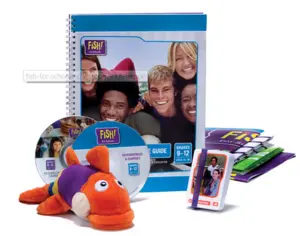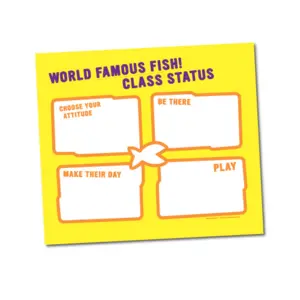A blog about leadership in schools: Welcome back to the reason you originally became a schoolteacher
Call for price
+45 71 92 55 63
Welcome back to the reason you originally became a schoolteacher
FISH! the philosophy can be used in companies, in public offices, at home in the private sector - and all the places where we humans need to build strong relationships. Strong relationships lead to good cooperation, good service, good sales and good learning.
FISH! the philosophy contains a wealth of practical messages that are ready to be applied. Here is a series of inspirations for Denmark's school teachers. You need some fresh sources of inspiration so you can guide your students. When the foundation of the classroom consists of caring relationships, students feel connected. At the same time, they are more likely to take care of themselves and the community of which they are a part.
FISH! philosophy is not yet another task that teachers now have to perform as well. FISH! is about the way we do what we already do.
FISH! is an invitation. The easiest way to bring FISH to life! in the classroom is to offer it and allow those who want to participate to join.
This series of 'inspirations' is excerpts taken from FISH! FOR SCHOOLS material. If you want to know more, contact us on telephone 71 92 55 63.
Welcome back to the reason you became a teacher 1
Exercise: Good and bad
Time: 15 minutes
Materials Required: None
Purpose: Discover new perspectives on the tasks that students perform.
Ask students to imagine that school is their full-time job. Write GOOD and DIRTY in 2 columns on the board. For example, it is GOOD to be with your schoolmates every day. For example, it is DIRTY that you are not allowed to speak freely whenever you want. For example, it is GOOD to learn things that you will only need later. For example, it is DIRTY that you get bored.
Divide the students into 3 man groups and give each group one from the DIRTY column. Ask students to come up with many good ideas for how DIRTY can become an activity they enjoy or at least make tolerable.
Ask for the groups' feedback and write the new ideas in the column instead of the original. Now ask students to find out what these new ideas can be used for.
Welcome back to the reason you became a teacher 2
'We do not stop playing because we are getting older. We're getting older because we stop playing. ' George Bernard Shaw
Welcome back to the reason you became a teacher 3
Exercise: Daydreaming
Time: 15 minutes
Necessary materials: 1 pc. joke drawing for each student
Purpose: Try to formulate positive descriptions of daydreams.
Write these 7 daydreams on the board and ask students to write them down and prioritize them from 1 to 7 (1 for most ideal on the next day off):
Go to the cinema
Take a picnic with the family
Go to the beach with some friends
Skiing, jogging or performing a third sporting activity
Play video games
Go shopping
Sleep
Group the students in relation to the activity they prioritized as No. 1. Ask the groups to note at least 5 good reasons why they prioritized the specific activity first. Then ask the groups to come up with at least 3 reasons why one of the other activities could be just as attractive, even if it was not given such a high priority. Talk about the lists in the whole class, about how the exercise illustrates the diverse points of view - that ideas and situations can always be considered with different glasses.
What similarities are there between the exercise and FISH! the philosophy, where it is about understanding other people's way of looking at things and spotting the possibilities that lie in changing one's own perspective.
Distribute 1 joke drawing to each student with the text removed. Now ask students to come up with 3 different versions of the caption.
Welcome back to the reason you became a teacher 4
Exercise: What is FISH !?
Time: 15 minutes
Materials Required: None
Purpose: Students put their definitions on FISH! the 4 principles of philosophy.
Ask students to sit in 4 equal groups during the 4 FISH! principles. Ask the groups to define:
What is 'Be present'?
What is 'Play'?
What is 'Make them happy' ?, and
What is 'Choose your position'?
Ask students from the other groups to contribute angles, views and ideas to the definitions across the groups. Agree what you want to use these definitions for!
Welcome back to the reason you became a teacher 5
Exercise: The flea market
Time: 15 minutes
Materials Required: None
Purpose: To make students aware of the importance of individual and joint contributions to the community.
Divide the class of students into groups of 4 to 5 participants. Ask students to collect 30 to 40 effects from their pockets, bags, and backpacks in a pile in their assigned team area. These can be effects such as coins, lip balms, cinema tickets, paper clips, pens, photos, receipts, ID cards, etc. Ask each group to choose a 'Guardian', who is the only person who must stand upright and who must show the effect that the other participants have found on the 'Kræmmermarkedet'. When the teacher asks for an effect,
the participants of the groups lead the effect as soon as possible and let the Guardian show it.
The exercise can start and the teacher can ask for 1 of these effects:
A keychain with at least 5 keys.
A pencil without an eraser.
A coin from the year 2008.
A voucher from a local restaurant.
A piece of chewing gum.
A colored paper clip.
A photo of a mother.
A pen with a company name on it.
An ID card with a date of birth in May or June on.
If the effect is approved, the group gets 1 point. Group participants must not leave their team area to collect more effects. Play eg 5 rounds and name the group with the most points as the winner.
Ask the groups (let the groups discuss the question first for 20 seconds):
What are the values of being an effective team?
What are the values of being a team with effective participants?
What values does the individual participant's contribution to the overall group's performance have?
What does it take to make a group or a team good?
What does it take to make a participant good?
What similarities are there between this exercise and our weekdays?
What is important in a group work?
What is important about helping others?
Welcome back to the reason you became a teacher 6
Exercise: What was it I ate?
Time: 15 minutes
Materials needed: 1 candy, 1 licorice or 1 grape for each student
Purpose: Students find out what attendance is and what absence is and what value these have.
Ask students to close their eyes and keep their right arm outstretched.
Put 1 candy (or licorice or grape) in each hand and ask them to focus on what they can feel they have lying in their hand.
Then ask students to smell the object, still with their eyes closed.
Now they must well open their eyes and look at the object.
Then ask students to put the item in their mouth and store it there. The object must not be chewed.
Ask them to close their eyes again and focus on the shape and aroma of the item as it deposits flavors in the mouth.
Now ask your students:
What does it mean when you are really focused?
What is the value of being focused on you? For others?
What disturbed your concentration so that you removed your presence from the object?
In what ways can you avoid being distracted and stay focused?
How does focusing match 'be present'?
Now hand out item # 2 and ask students to chew and swallow quickly. Then talk about focusing on the object and sinking it thoughtlessly.
Now agree on what you want to use your discoveries for.
Welcome back to the reason you became a teacher 7
Exercise: Hello, hello!
Time: 15 minutes
Materials Required: None
Purpose: Students design one or more 'Be present' signals.
Explain to students that they should now try to design the class's very own 'Be present' signal when everyone's attention is required. First you have to try some different genres and then vote on which type of signal most people like. The teacher reviews the examples:
First example
The teacher whispers, 'If you hear me, clap once.'
One or more students respond with 1 clap.
Then the teacher says, 'If you hear me, clap twice.'
All students respond with 2 pats.
Second example
The teacher says, '1, 2, 3,' Let us have some peace! '
Students answer: '1, 2,' you can believe it '.
Third example
The teacher says and shows at the same time with the hand: 'When the hand opens, the mouth closes in.'
Fourth example
The teacher claps a rhythm or a pattern.
Students respond with an echo of the pattern.
Fifth example
The teacher sings: ‘Here she comes, just walking down the street singin…’
Students respond, "Do wa diddy diddy dum diddy do."
Who votes for 1, 2, 3, 4 and 5. There are most votes for X. What variations can we design so that we have more to use when we need to have peace in the class. Divide the students into small groups and let them invent new variations. Give them a few minutes and get the suggestions presented. Once you have heard the new signal or signals, try them again and practice in them. Thank you all for their exquisite creativity. The signal must be used by everyone when everyone's attention is required. Ask students from time to time what value the signal has had on classroom attention, how the signal has affected classroom productivity, and in what ways the signal has helped classroom communication.
When the signal is worn, find a new one.
Welcome back to the reason you became a teacher 8
Exercise: Who are you?
Time: 15 minutes
Materials needed: 1 prize (a licorice stick, an older memorable LP or similar)
Purpose: Students get to know each other better and improve their relationships.
Ask students to stand in a large circle. Ask a student to start by saying their name aloud followed by something factual that is a little unusual. For example, ‘My name is Ole, and I know how to change the oil on a car.’ When everyone has had a turn, everyone should try again to see if they can remember what was said. Complete a random round where Ole starts
with himself and then have to repeat the 2 that stand to his left. Continue until everyone has tried this.
Now give the prize to the student who completed his trip most fluently.
Then ask students: What does it mean to use each other's names? How do you best and quickly learn other people's names (repeat the name, focus on what the other person is saying and not yourself, connect something interesting to the name, etc.)?
Written by Michael Meinhardt, LEADERS WAREHOUSE.
There is no reviews yet. Be the first to write us your opinion








